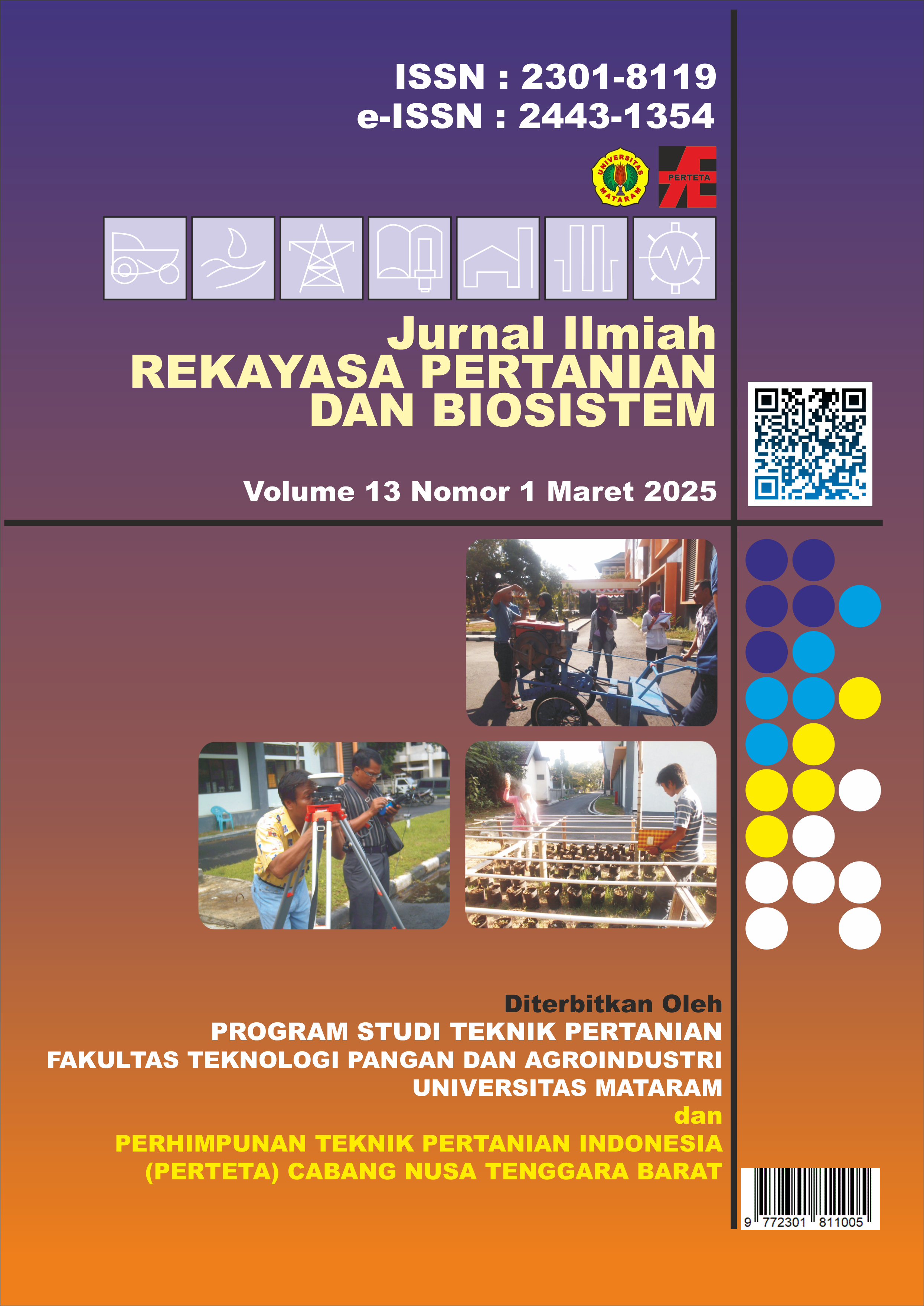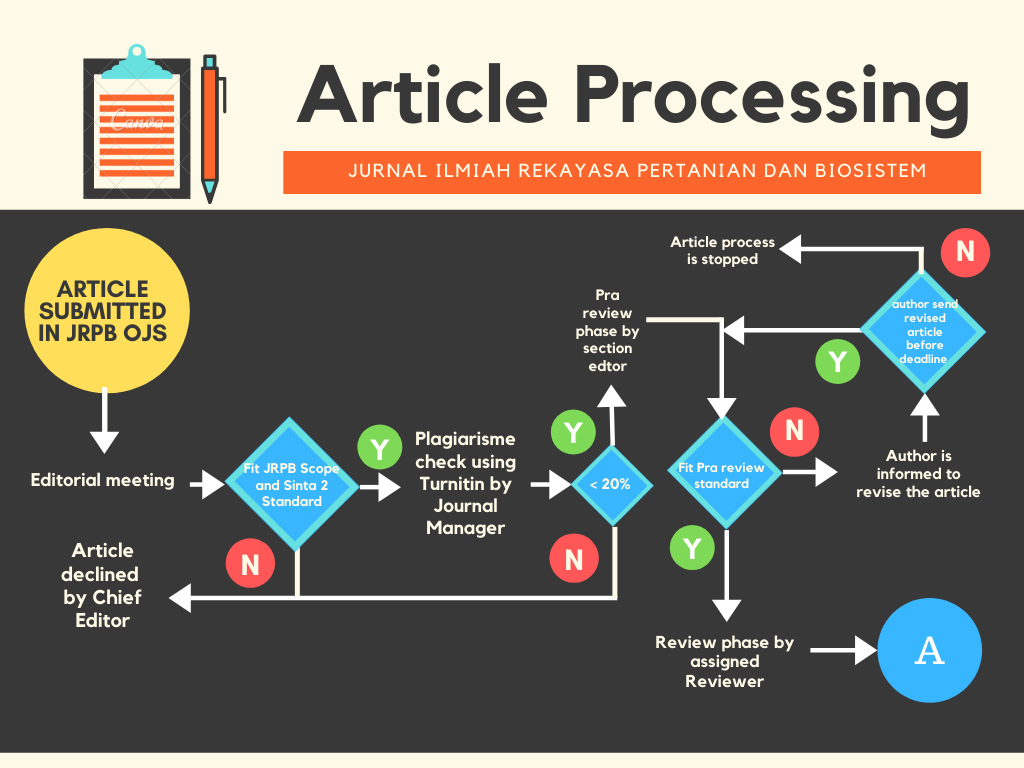Spatial Analysis of Landslide Potential in Agricultural Areas of Wadaslintang Catchment Area, Central Java Province Indonesia
Authors
Gina Isna Nafisa , Chandra Setyawan , Ngadisih Ngadisih , Sahid Susanto , Nur Ainun Harlin Jennie PulunganDOI:
10.29303/jrpb.v13i1.678Published:
2025-03-27Issue:
Vol. 13 No. 1 (2025): Jurnal Ilmiah Rekayasa Pertanian dan BiosistemKeywords:
Catchment Area, GIS, Landslides, Spatial AnalysisArticles
Downloads
How to Cite
Downloads
Abstract
Landslides have occurred in several tropical regions of Indonesia and caused many losses in both upstream and downstream areas. This study aims to identify landslide prone areas in the Wadaslintang catchment area, Central Java Province Indonesia. Nine parameters were used to analyze landslide potential such as land use, land slope, rainfall, constituent rocks, soil type, soil permeability, population density, drainage density and runoff coefficient. Each parameter has five possibility scores (1 to 5) determined based on certain criteria. The value of each parameter was presented in a raster map with 15 meters of resolution and analyzed in ArcGIS 10.8. The level of landslide susceptibility was classified into five categories. The relationship between landslides and the triggered factor was analyzed using Frequency Ratio (FR). The result showed that the parameters with the highest FR values were land use, land slope, rainfall, and soil permeability, indicating a strong influence on landslides. Very high vulnerability areas were found in mixed farmland and settlements especially on steep slopes. Area with moderate and low categories of landslide vulnerability covers the largest area of the study site with an occupied area of 98.54 km2 (51.04% of the total area) and 57.91 km2 (29.99% of the total area), respectively. While the others i.e., areas with the very low, high and very high categories, occupy around of 3.74 km2 (1.94% of the total area), 30.94 km2 (16.02% of the total area), and 1.93 km2 (1% of the total area) respectively. Validation results indicated that landslides mostly occurred in areas with medium and high categories of landslide vulnerability.
References
Ahmad, A., Farida, M., Juita, N., & Amin, N. (2022). Soil erodibility mapping for soil susceptibility in the upstream of Kelara Subwatershed in Jeneponto Regency. IOP Conference Series: Earth and Environmental Science, 986(1). https://doi.org/10.1088/1755-1315/986/1/012031 DOI: https://doi.org/10.1088/1755-1315/986/1/012031
Arekhi, M., Goksel, C., Sanli, F. B., & Senel, G. (2019). Comparative evaluation of the spectral and spatial consistency of Sentinel-2 and Landsat-8 OLI data for Igneada longos forest. ISPRS International Journal of Geo-Information, 8(2). https://doi.org/10.3390/ijgi8020056 DOI: https://doi.org/10.3390/ijgi8020056
Arrofiqoh, E., & Harintaka. (2016). Pemantauan Kawasan Sabuk Hijau Waduk Wadaslintang Menggunakan Citra Satelit Landsat 8. Journal Geodesi UGM. http://journal.geodesi.ugm.ac.id
Arsyad, S. (2006). Konservasi Tanah dan Air (Soil and Water Conservation). IPB Press. Bogor
Astuti, E. M., Widyatmoko, D. S., & Sudibyakto. (2015). Analisis Risiko Tanah Longsor Desa Tieng Kecamatan Kejajar Kabupaten Wonosobo. 133–149.
Ayudya, Prita & Muryamto, Rochmad. (2024). A Development of A Flood Vulnerability Level Map Using Scoring and Weighting Methods in Bogowonto Sub Watershed. Journal of Geospatial Science and Technology. 2. 19-36. 10.22146/jgst.v2i1.6113. DOI: https://doi.org/10.22146/jgst.v2i1.6113
BNPB. (2016). Risiko Bencana Indonesia (Disaster Risk in Indonesia).
BNPB. (2022). Tanah Longsor dan Angin Kencang Terjang Wonosobo Dampak Cuaca Ekstrem. Diakses melalui https://www.bnpb.go.id/
Çellek, S. (2019). Effect of Stream Distance on Landslide. 3rd International Symposium on Innovative Approaches in Scientific Studies, 268–275.
Çellek, S. (2020). Effect of the Slope Angle and Its Classification on Landslide. Natural Hazards and Earth System Sciences. https://doi.org/10.5194/nhess-2020-87 DOI: https://doi.org/10.5194/nhess-2020-87
Deristani, A., Mujiyo, & Hidayat, A. (2023). Analysis of landslide susceptibility in Tirtomoyo Watershed, Central Java, Indonesia. IOP Conference Series: Earth and Environmental Science, 1180(1). https://doi.org/10.1088/1755-1315/1180/1/012039 DOI: https://doi.org/10.1088/1755-1315/1180/1/012039
Donie, S., Harjadi, B., Wahyuningrum, N., & Adi, R. N. (2018). Pengendalian Erosi Jurang (D. Ariyanto & A. Supangat, Eds.; 1st ed.). Balai Penelitian dan Pengembangan Teknologi Pengelolaan Daerah Aliran Sungai (BPPTPDAS).
Firdaus, M. A., Wicaksana, M. A., Hilmi, M. Z., Syafatullah, M. D. A., Romaita, N. R., Kristianti, Q. V. D., Soekamto, H., & Putra, A. K. (2021). Pengaruh alih fungsi lahan terhadap resiko longsor di Desa Ngadirejo. Jurnal Integrasi Dan Harmoni Inovatif Ilmu-Ilmu Sosial (JIHI3S), 1(7), 852–859. https://doi.org/10.17977/um063v1i7p852-859 DOI: https://doi.org/10.17977/um063v1i7p852-859
Froude, M. J., & Petley, D. N. (2018). Global fatal landslide occurrence from 2004 to 2016. Natural Hazards and Earth System Sciences, 18(8), 2161–2181. https://doi.org/10.5194/nhess-18-2161-2018 DOI: https://doi.org/10.5194/nhess-18-2161-2018
Hairiah, K., Widianto, W., Suprayogo, D., & Van Noordwijk, M. (2020). Tree roots anchoring and binding soil: Reducing landslide risk in Indonesian agroforestry. Land, 9(8). https://doi.org/10.3390/LAND9080256 DOI: https://doi.org/10.3390/land9080256
Jeong, S., Lee, K., Kim, J., & Kim, Y. (2017). Analysis of rainfall-induced landslide on unsaturated soil slopes. Sustainability (Switzerland), 9(7). https://doi.org/10.3390/su9071280 DOI: https://doi.org/10.3390/su9071280
Karlina, B., Damayanti, A., & Supriatna. (2019). Spatial Analysis of Erosion of the Upstream Citarum Watershed in Kabupaten Bandung. IOP Conference Series: Earth and Environmental Science, 248(1). https://doi.org/10.1088/1755-1315/248/1/012074 DOI: https://doi.org/10.1088/1755-1315/248/1/012074
Kuradusenge, M., Kumaran, S., & Zennaro, M. (2020). Rainfall-induced landslide prediction using machine learning models: The case of ngororero district, rwanda. International Journal of Environmental Research and Public Health, 17(11), 1–20. https://doi.org/10.3390/ijerph17114147 DOI: https://doi.org/10.3390/ijerph17114147
Lin, Q., Steger, S., Pittore, M., Zhang, Y., Zhang, J., Zhou, L., Wang, L., Wang, Y., & Jiang, T. (2023). Contrasting Population Projections to Induce Divergent Estimates of Landslides Exposure Under Climate Change. Earth’s Future, 11(9). https://doi.org/10.1029/2023EF003741 DOI: https://doi.org/10.1029/2023EF003741
Mahmoud, S. H., & Alazba, A. A. (2015). Hydrological response to land cover changes and human activities in arid regions using a geographic information system and remote sensing. PLoS ONE, 10(4). https://doi.org/10.1371/journal.pone.0125805 DOI: https://doi.org/10.1371/journal.pone.0125805
Muñoz-Torrero Manchado, A., Antonio Ballesteros-Cánovas, J., Allen, S., & Stoffel, M. (2022). Deforestation controls landlside susceptibility in Far-Western Nepal. Catena, 219. https://doi.org/10.1016/j.catena.2022.106627 DOI: https://doi.org/10.1016/j.catena.2022.106627
Muzani. (2021). Buku Referensi Bencana Tanah Longsor Penyebab dan Potensi Longsor. DeePublish. Yogyakarta.
Nakileza, B. R., & Nedala, S. (2020). Topographic influence on landslides characteristics and implication for risk management in upper Manafwa catchment, Mt Elgon Uganda. Geoenvironmental Disasters, 7(1). https://doi.org/10.1186/s40677-020-00160-0 DOI: https://doi.org/10.1186/s40677-020-00160-0
Nelson, S. A. 2013. Slope Stability, Triggering Events, Mass Movement Hazards. Diakses melalui https://www2.tulane.edu/
Nseka, D., Bamutaze, Y., Mugagga, F., & Nakileza, B. (2019). The Fragility of Agricultural Landscapes and Resilience of Communities to Landslide Occurrence in the Tropical Humid Environments of Kigezi Highlands in South Western Uganda. In Climate Change Management (pp. 279–305). Springer. https://doi.org/10.1007/978-3-030-12974-3_13 DOI: https://doi.org/10.1007/978-3-030-12974-3_13
Octaviarini, I. S., Fathani, T. F., Hardiyatmo, H. C., Amalina, A. N., & Erzagian, E. (2023). The Mechanism of Rainfall-Induced Landslide Around Railway Tracks in Central Java Province, Indonesia. INERSIA Lnformasi Dan Ekspose Hasil Riset Teknik Sipil Dan Arsitektur, 19(2), 212–222. https://doi.org/10.21831/inersia.v19i2.66835 DOI: https://doi.org/10.21831/inersia.v19i2.66835
Putra, A. N., Nita, I., Jauhary, M. R. Al, Nurhutami, S. R., & Ismail, M. H. (2021). Landslide risk analysis on agriculture area in pacitan regency in east java indonesia using geospatial techniques. Environment and Natural Resources Journal, 19(2), 141–152. https://doi.org/10.32526/ennrj/19/2020167 DOI: https://doi.org/10.32526/ennrj/19/2020167
Qin, H., He, J., Guo, J., & Cai, L. (2022). Developmental characteristics of rainfall-induced landslides from 1999 to 2016 in Wenzhou City of China. Frontiers in Earth Science, 10. https://doi.org/10.3389/feart.2022.1005199 DOI: https://doi.org/10.3389/feart.2022.1005199
Rusdi, M., Roosli, R., & Ahamad, M. S. S. (2015). Land evaluation suitability for settlement based on soil permeability, topography and geology ten years after tsunami in Banda Aceh, Indonesia. Egyptian Journal of Remote Sensing and Space Science, 18(2), 207–215. https://doi.org/10.1016/j.ejrs.2015.04.002 DOI: https://doi.org/10.1016/j.ejrs.2015.04.002
Schneider, P., Brönnimann, C., Stähli, M., & Seibert, J. (2015). Landslides and the interplay of infiltration, soil permeability and bedrock exfiltration on steep slopes. In Geophysical Research Abstracts (Vol. 17).
Senanayake, S., Pradhan, B., Huete, A., & Brennan, J. (2020). Assessing soil erosion hazards using land-use change and landslide frequency ratio method: A case study of Sabaragamuwa province, Sri Lanka. Remote Sensing, 12(9). https://doi.org/10.3390/RS12091483 DOI: https://doi.org/10.3390/rs12091483
Setiadi, G., Paripurno, E., & Sungkowo, A. (2014). GEOLOGI DAN ANALISIS RISIKO BENCANA LONGSOR DESA WAGIRPANDAN, WONOHARJO, DAN SEKITARNYA, KECAMATAN ROWOKOELE, KABUPATEN KEBUMEN, PROVINSI JAWA TENGAH. UPN Veteran Yogyakarta.
Sharma, A., Rai, P. K., Singh, P., & Srivastava, P. K. (2020). Probabilistic Landslide Hazard Assessment using Statistical Information Value (SIV) and GIS Techniques: A Case Study of Himachal Pradesh, India. In Techniques for Disaster Risk Management and Mitigation (pp. 197–208). wiley. https://doi.org/10.1002/9781119359203.ch15 DOI: https://doi.org/10.1002/9781119359203.ch15
Silalahi, F. E. S., Pamela, Arifianti, Y., & Hidayat, F. (2019). Landslide susceptibility assessment using frequency ratio model in Bogor, West Java, Indonesia. Geoscience Letters, 6(1). https://doi.org/10.1186/s40562-019-0140-4 DOI: https://doi.org/10.1186/s40562-019-0140-4
Sukristiyanti, S., Maria, R., & Lestiana, H. (2018). Watershed-based Morphometric Analysis: A Review. IOP Conference Series: Earth and Environmental Science, 118(1). https://doi.org/10.1088/1755-1315/118/1/012028 DOI: https://doi.org/10.1088/1755-1315/118/1/012028
Sulastriningsih, H. S., Tewal, S. T. R., & Suoth, G. F. E. (2021). Evaluation of Landslide Based Settlement Distribution in Manado City. IOP Conference Series: Materials Science and Engineering, 1125(1), 012101. https://doi.org/10.1088/1757-899x/1125/1/012101 DOI: https://doi.org/10.1088/1757-899X/1125/1/012101
Tang, L., Wang, L., & Zhang, W. (2019). Assessing the Stability of Poor Drainage Soil Slopes under the Combined Effect of Water Level Drawdown and Rainfall. IOP Conference Series: Earth and Environmental Science, 304(4). https://doi.org/10.1088/1755-1315/304/4/042024 DOI: https://doi.org/10.1088/1755-1315/304/4/042024
Wahidah, A. N., Martono, D. N., & Supriatna. (2022). Land use sustainability to mitigate potential land slide in Ciletuh watershed, Sukabumi, Indonesia. IOP Conference Series: Earth and Environmental Science, 950(1). https://doi.org/10.1088/1755-1315/950/1/012006 DOI: https://doi.org/10.1088/1755-1315/950/1/012006
Wei, Y., Wu, X., Xia, J., Miller, G. A., Cai, C., Guo, Z., & Arash, H. (2019). The effect of water content on the shear strength characteristics of granitic soils in South China. Soil and Tillage Research, 187, 50–59. https://doi.org/10.1016/j.still.2018.11.013 DOI: https://doi.org/10.1016/j.still.2018.11.013
Xiong, H., Ma, C., Li, M., Tan, J., & Wang, Y. (2023). Landslide susceptibility prediction considering land use change and human activity: A case study under rapid urban expansion and afforestation in China. Science of the Total Environment, 866. https://doi.org/10.1016/j.scitotenv.2023.161430 DOI: https://doi.org/10.1016/j.scitotenv.2023.161430
Yogiswara, G., Putranto, T. T., & Trisnawati, D. (2020). Potensi Longsor di Kabupaten Kendal, Provinsi Jawa Tengah Berdasarkan Penginderaan Jauh. Jurnal Geosains dan Teknologi, 3(3) DOI: https://doi.org/10.14710/jgt.3.3.2020.135-148
Youssef, B., Bouskri, I., Brahim, B., Kader, S., Brahim, I., Abdelkrim, B., & Spalević, V. (2023). The contribution of the frequency ratio model and the prediction rate for the analysis of landslide risk in the Tizi N’tichka area on the national road (RN9) linking Marrakech and Ouarzazate. Catena, 232. https://doi.org/10.1016/j.catena.2023.107464 DOI: https://doi.org/10.1016/j.catena.2023.107464
Zheng, S., Zhang, G., Yuan, X., Ye, F., & Fu, W. (2020). Failure characteristics of shallow soil slope considering surface runoff and interstitial flow. Geomatics, Natural Hazards and Risk, 11(1), 845–868. https://doi.org/10.1080/19475705.2020.1758222 DOI: https://doi.org/10.1080/19475705.2020.1758222
License
Copyright (c) 2025 Gina Isna Nafisa, Chandra Setyawan, Ngadisih Ngadisih, Sahid Susanto, Nur Ainun Harlin Jennie Pulungan

This work is licensed under a Creative Commons Attribution-ShareAlike 4.0 International License.
Authors who publish with this journal agree to the following terms:
- Authors retain copyright and grant the journal right of first publication with the work simultaneously licensed under a Creative Commons Attribution License 4.0 International License (CC-BY-SA License). This license allows authors to use all articles, data sets, graphics, and appendices in data mining applications, search engines, web sites, blogs, and other platforms by providing an appropriate reference. The journal allows the author(s) to hold the copyright without restrictions and will retain publishing rights without restrictions.
- Authors are able to enter into separate, additional contractual arrangements for the non-exclusive distribution of the journal's published version of the work (e.g., post it to an institutional repository or publish it in a book), with an acknowledgement of its initial publication in Jurnal Ilmiah Rekayasa Pertanian dan Biosistem (JRPB).
- Authors are permitted and encouraged to post their work online (e.g., in institutional repositories or on their website) prior to and during the submission process, as it can lead to productive exchanges, as well as earlier and greater citation of published work (See The Effect of Open Access).










